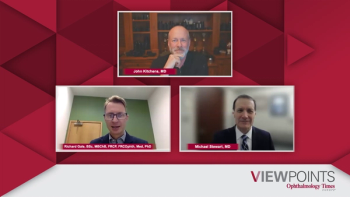
Impact of COVID-19 on management of DR/DME
Episodes in this series

Rishi Singh, MD: Let’s talk about COVID-19 [coronavirus disease 2019] and its impact on caring for some of these patients. Steven, lead off and tell us how COVID-19 has affected your patient clinics [with the Sepulveda VA Hospital].
Steven G. Ferrucci, OD, FAAO: It’s been difficult because, for a while, we were shut down and tried to perform only urgent and emergent examinations. It unfortunately pushed back some exams for patients with diabetes, especially routine exams, yearly exams, and 6- or 9-month follow-ups. It’s been a challenge with those patients because some of them got delayed treatment or at least delayed exams. We now seem to getting around the corner, and we seem to be doing a bit better, at least with getting our patients back in.
Rishi Singh, MD: Dr Chous, would you like to comment on how COVID-19 affected your practice [at Chous Eye Care Associates]?
A. Paul Chous, MA, OD, FAAO: Yes, it slowed things down dramatically for a while, and I’m now back to seeing a lot of patients who are 80 or 90 years old who have had type 2 diabetes for 30 or 40 years. The most important message we can give is that these patients are at dramatically increased risk for bad outcomes if they end up in the hospital for COVID-19, and it’s directly related to their glycemic control. If you have poor blood sugar control, you’re 5 to 10 times more likely to suffer a fatality. That’s the first thing I stress to my patients when I see them. We need to assure patients that they can safely come to our offices and that we’re taking proper protocols to disinfect the office. My advice to my colleagues is to minimize face-to-face exam time because the patient’s risk is higher the longer they’re in an enclosed room. That’s sound advice for anybody in this time.
Rishi Singh, MD: Dr Loewenstein, I have the same question. How has COVID-19 affected your practice [at Tel Aviv University] with regard to volume of patients, and what’s now happening when the patients return?
Anat Loewenstein, MD: Yes. First, at the peak of the pandemic, we had to slow down. We also worked in capsules, so we had only one-third of the staff come to the hospital every day, and two-thirds of the staff were free. What we did was this: we reached out to the patients. We opened with 3 optional solutions. First, we tried to provide the safe environment in our hospital, but for the patients who did not want to come, we also opened a remote clinic outside of the hospital. We got a donation from WeWork in Israel, and we did an injection clinic there. We did OCT [optical coherence tomography] imaging with a clinical examination and treated the patients. That was wonderful.
We did another thing. Since I had a lot of physicians who were not in the capsule working, I sent people to patients’ homes to inject. Physicians were going to patients’ homes. For example, for patients who were in loading phases, or for whom you knew treatments were needed on a fixed regimen, we injected in patients’ homes. Nowadays, everyone is in to work. We don’t work in capsules anymore, so I don’t have the resources to do that. I need the physicians in the hospital. We’re trying to provide exactly what was said here. We’re trying to give a safe environment. We’re keeping social distance. We’re trying to not admit patients into the clinic until they’re going to be seen by physicians. We’re sending them a text message that we are ready to see them. If patients are worried and don’t want to have the time spent in the clinic, I agree that the shorter the visit that we do, the better the patients are. If the patient doesn’t want to have an OCT, I sometimes move to a fixed regimen.
There have been a lot of rumors that we may not need to do visual acuity examinations so often. I’m talking about the physicians. Some people say we should only do OCT imaging and treat the patient, that’s it; the visual acuity examination does not make such a big difference, at least not by the physician at every visit. Rather, the patient can go to the optometrist and have this done. Also for the OCT, if they don’t need an injection, it may be a safer environment than the hospital.
Newsletter
Get the essential updates shaping the future of pharma manufacturing and compliance—subscribe today to Pharmaceutical Technology and never miss a breakthrough.


















































